
The Salon du Tapis d'Orient is a moderated discussion group in the manner of the 19th century salon devoted to oriental rugs and textiles and all aspects of their appreciation. Please include your full name and e-mail address in your posting.
by R. John Howe
In his great book, The Persian Carpet, Cecil Edwards expresses a great many opinions about the qualities
of Persian rugs that existed during his time. Among other things, it seems clear that he considered Kerman designs
to be of the highest aesthetic quality. But it is important to remember that Edwards was the employee of an English
firm that organized and supported and sold the products of rug weavers in Iran. So while it is likely that he knew
a "good rug" when he saw one, and although the Iranians paid him the great compliment of translating
his book into Farsi, Edwards was clearly looking at rugs from the viewpoint of someone "in the business,"
rather than from that of a "collector."
Folks like Edwards, in the rug literature, do not talk much in their writings about what rugs of their era might
turn out to be particularly desirable to collectors. He seems to imply that he was involved in the revival of rug
weaving in Kashan but doesn't hint that he foresaw how much "Manchester Kashans" might be valued today.
And collectors tend to look back, rather than ahead. Each generation seems to have the same complaint, that the
truly great age of collecting opportunities, existed in the time just prior to the one in which they reside. Most
collectors look these days for 19th century material, mouthing the same phrases about it that the collectors of
the early part of the 20th century used as they lauded 18th century rugs. And collectors of our time also say derogatory
things about most 20th century rugs that resemble those that collectors in the early 1900s said about 19th century
material. One visible pattern in all of this is that most collectors do not scrutinize the rug production of their
time, attempting to determine what items being made then (that is, "now") will be, and hence, "are,"
worthy of collection.
And to complicate things further, each age has its collecting fashions. As the 19th century ended and the 20th
century began, great classic carpets were the rage. The 15th and the 16th centuries were considered the true apex
of rug quality and while nice "decorative" 18th century material was worthy perhaps of collection, it
was usually clearly "derivative" and could often be described as "degenerate." Rugs books of
this time openly sneer at the "crudeness" of "tribal" pieces and offer theories of why "curvilinear"
design is superior. Nowadays, the sneering is at dyes that are suspected of not being "natural," and
material that was likely woven after 1850 is subjected to descriptions that suggest the beginnings of disapproval.
Today, city rugs and curvilinear decorative rugs are not sought after by most and Ghiordes prayer rugs, once crème
de le crème of that design format, do not attract much attention.
All this is preliminary to suggesting that in this Salon we look ahead to the year 2101 and try to estimate as
best we can what material might interest collectors then and why we think so.
I have a rug dealer friend who has said to me that he thinks this is a hopeless task, since there are so very many
rugs being woven now. And he has a point. But let me make an argument here for one set of rugs being woven today
in which I think it is likely that some of the rugs that will be sought by collectors in 2101 reside.
This set of rugs, you will likely not be surprised to hear, are those currently being made with handspun wools
and natural dyes. The selection of this group deals effectively with my dealer friend's concern about an unmanageable
contemporary universe, because, as Emmett Eiland reports in his book, Oriental Carpets Today, only about
3% of the rugs currently being made use handspun wools and natural dyes. Jane Ware, in her useful little resource
book, disadvantaged with the misleading title, The Official Oriental Rug Price Guide, not only calls attention
to the possibility that this group of rugs may be strong candidates for those likely to be collected in the future,
but indicates that some are doing it already. Eiland, himself, says that he is one of these.
And some recognized authorities agree that some contemporary rugs are worthy of collection. I've told this story
before, but I was in Walter Denny's home a few years ago, when he threw a small contemporary Turkish jewel of a
rug with spectacular colors, out on the floor in front of a group experienced rug collectors, and challenged them
to say why this rug was not already worthy of collection. I do not recall any takers.
Here are some examples of this particular part of contemporary production to help you estimate whether my prediction
has any merit for you.

If our future collector's tastes are grand, it seems likely that there will be rugs from our time to match
them. The rug above was woven recently in Turkey by Woven Legends and, as many of your will recognize, was inspired
by an old Persian Bidjar design. This rug is 12'1" X 19'1" and has cotton warps and weft.
Or if a future collector likes less traditional designs and superior wool, the Zollanvari weavers in Southern Iran
are weaving contemporary Gabbehs like this one.
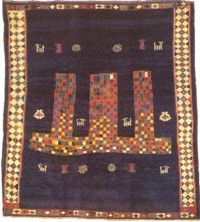
This rug is 263 X 229 cm and was woven before 1991. The quality of the wool used in them is widely admired.
The kilim collector of the future will likely be able to find items like this piece woven in the Konya area in
Turkey but with a design perhaps based on an old Caucasian embroidery.
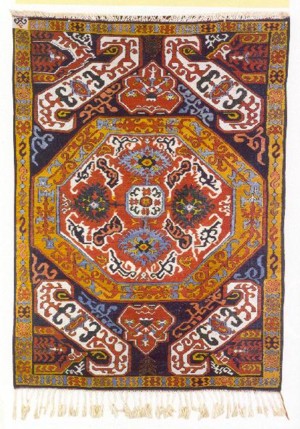
This piece was imported by Paul Ramsey, the Denver dealer/rug student, who had his own kilim production in
Turkey.
The collector who likes pile but kilim designs may be able to find a piece like this.
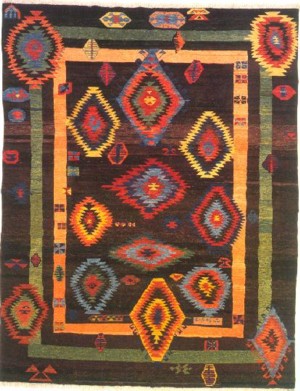
This Woven Legends rug is about 7'8" X 9'11".
I'm not sure that most of the Turkmen materials being woven now will fool most collectors in 2101. Here, for example,
is a contemporary Ersari piece that I own.
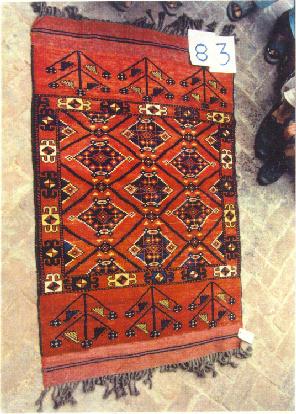
Although I like the color in this piece and I like it graphically, I wish that its wool was of a little higher
quality. It's not bad, just more homogenized and not the result of the sorting of the kind that was behind the
wool in many 19th century Turkmen pieces. This little rug, a little less than 3' X 4,' is from Chris Walter's Cultural
Survival production by Afghan Ersari refugees in Pakistan.
There are a number of classic Beshiri designs available in this production and there is at my feet as I write a
pretty good near copy by Cultural Survival weavers of the Yomut "jewelry" asmalyk that is Plate 193 in
Jourdan's "Turkoman" volume. Most of Chris' Ersari production is signed with the name of the weaving
family, the name of the refugee camp where they resided and the date.
And if the collector of the future is interested in Tibetan material, there is also a Cultural Survival production
of traditional Tibetan designs and structure in Nepal.

This is a new rug from this production in a classic Tibetan door rug design.
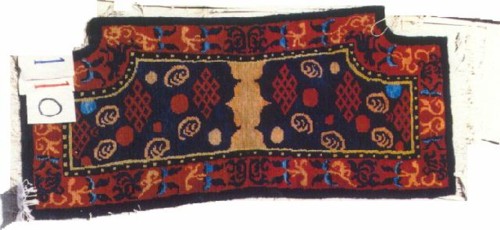
The second Tibetan piece is a Cultural Survival saddle rug that I own and bought on the basis of the range
of good color in it. This Tibetan production uses wool that is half from Tibetan sheep and half from Australian
Merinos. Although the structure is a traditional Tibetan one, the handle is much stiffer than the rather floppy
old Tibetans one encounters.
I have not mentioned Harald Bohmer's DOBAG production in Turkey that is generally given credit for starting the
hand spun wool, natural dye production in the mid-1980s. (There was a small South Persian production supported
by the queen in the 1970s from which I have a brightly colored kilim.)
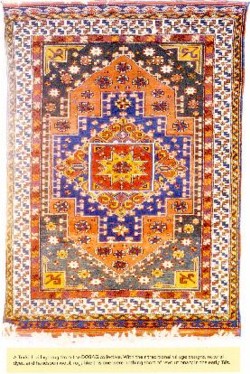
The colors in this DOBAG rug are a good deal less intense than those of most of them that I have seen. These
rugs also have a good, hard wool. The production is still small but there is no doubt that the effect of Bohmer's
coops on world rug production has be very great. DOBAG rugs have leather tags and should be easy to identify.
And while I don't want to tire you, I haven't shown you what early Woven Legends production looked like.
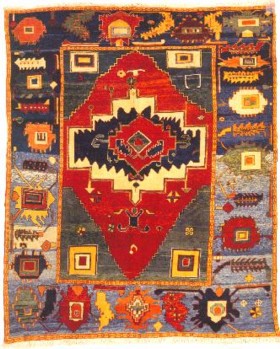
Or how wonderful its Azeri production could be.
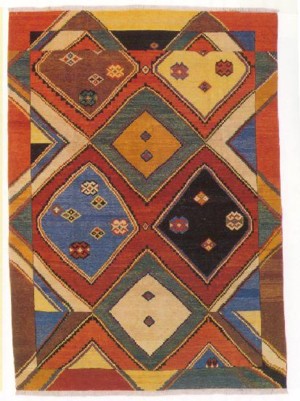
Or what the variety of pieces produced by its Black Mountain Looms includes.
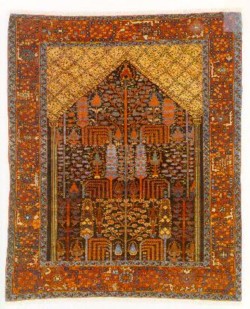
The room-size piece, above, is a Little River piece from Black Mountain Looms, like one that Emmett Eiland
says he has, himself, already collected.
Finally, here is a custom rug:
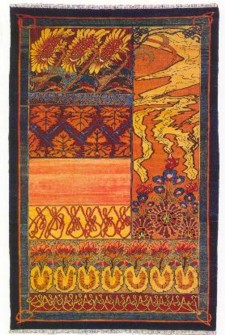
It was produced by the Kentwilly segment of Black Mountain Looms for Leslie Stroh, publisher of Rug News.
Mr. Stroh had a hand in its design. This piece is 10' X 20' and may not be to everyone's taste. But as Emmett Eiland
points out in his caption on it, this is an example of the truly creative design going on in the rugs being woven
as you read.
I think collectors in 2101 are, in part, going to be attracted to aesthetically pleasing pieces being woven in
the hand-spun wool, natural dye production of our day. They offer many of the advantages of the 19th century, in
addition to some of those of the 20th.
What do you think the collectors of 2101 will collect and why?
Regards,
R. John Howe
Note
Turkotek is a non-commercial site. We neither recommend nor critique rugs and textiles
currently for sale; we don't endorse or disparage contemporary producers of rugs and textiles; we don't talk about
what might be a reasonable price or allow postings that are likely to influence the marketing of rugs and textiles
currently for sale.
This Salon goes right to the edge of what we want to avoid. We have had some discussion about whether we should
identify specific contemporary producers and comment on the qualities of their production. Although good arguments
can be made for not doing so, we feared a rather pallid discussion might result and have decided to risk such identification
and descriptions.
Please note that our intention is speculation (it can be no more than that) about which contemporary rugs and textiles
are likely to interest collectors in 2101. We are emphatically not recommending rugs that should be considered
for purchase. The fact that some producers are mentioned and others are not reflects our limited knowledge and
availability of color images. It may well be that others with better information and related images will enlarge
our sampling of contemporary production and producers in the discussion.
I will police postings and remove any that cross the line that we mean to observe. I recognize that some might
have difficulty determining where that line is in this salon. I ask that you trust my good intentions in this regard.
Bibliography
Azizollahoff, J. R., The Illustrated Buyer's Guide to: Oriental Carpets, With Price Guide. Schiffer Publishing
Company: Atglen, PA, 1998.
Cultural Survival images from poor color Xerox pictures in my personal files.
Eiland, Emmett, Oriental Rugs Today, Berkeley Hill Books: Berkeley, CA, 2000.
Ware, Joyce C. The Official Price Guide to Oriental Rugs, Second edition, House of Collectibles: New York, N. Y.,
1996
Zollanvari ad from "Oriental Rug Review", Vol. 11, No. 4, page 2.